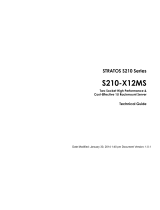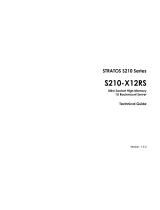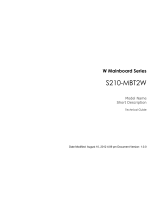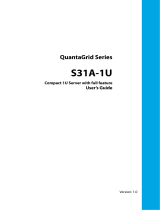Page is loading ...

MegaRAC™ K1
for Linux®-based
Operating Systems
User’s Guide
MAN-933-lnx
04/29/05

MegaRAC™ K1 for Linux®-based Operating Systems User’s Guide
ii
© Copyright 1985-2010 American Megatrends, Inc.
All rights reserved.
American Megatrends, Inc.
5555 Oakbrook Parkway, Building 200,
Norcross, GA 30093
This publication contains proprietary information which is protected by copyright. No
part of this publication can be reproduced, transcribed, stored in a retrieval system,
translated into any language or computer language, or transmitted in any form
whatsoever without the prior written consent of the publisher, American Megatrends, Inc.
All trademarks and trade names may be used in this document to refer to either the
entities claiming the marks and names or their products. American Megatrends, Inc.
disclaims any proprietary interest in trademarks and trade names other than its own.
Revision History
04/29/05 Initial Release.

Preface
iii
Table of Contents
Chapter 1 MegaRAC™ K1 for Linux®-based Operating Systems .......................................... 5
Installation .................................................................................................................................... 5
Remote Console Redirection Tool............................................................................................... 5
Remote Console Shortcut Key Combinations.......................................................................... 7
Redirection Menu ..................................................................................................................... 7
Color Menu............................................................................................................................... 7
View Menu................................................................................................................................ 8
Redirected Devices Menu ........................................................................................................ 8
Power Control........................................................................................................................... 8
Performance............................................................................................................................. 9
Keys.......................................................................................................................................... 9
Ports ......................................................................................................................................... 9
Options ..................................................................................................................................... 9
Help ........................................................................................................................................ 10
Remote Console Toolbar ....................................................................................................... 10
Video Parameters................................................................................................................... 10
lincuri Command Line Configuration Tool.................................................................................. 11
For Network Connections....................................................................................................... 11
For USB Inband Connections................................................................................................. 11
Command Line Commands ....................................................................................................... 12

MegaRAC™ K1 for Linux®-based Operating Systems User’s Guide
iv
Disclaimer
This manual describes the operation of the American Megatrends MegaRAC™ K1.
Although efforts have been made to assure the accuracy of the information contained
here, American Megatrends expressly disclaims liability for any error in this information,
and for damages, whether direct, indirect, special, exemplary, consequential or otherwise,
that may result from such error, including but not limited to the loss of profits resulting
from the use or misuse of the manual or information contained therein (even if American
Megatrends has been advised of the possibility of such damages). Any questions or
comments regarding this document or its contents should be addressed to American
Megatrends at the address shown on the inside of the front cover.
American Megatrends provides this publication “as is” without warranty of any kind,
either expressed or implied, including, but not limited to, the implied warranties of
merchantability or fitness for a specific purpose.
Some states do not allow disclaimer of express or implied warranties or the limitation or
exclusion of liability for indirect, special, exemplary, incidental or consequential
damages in certain transactions; therefore, this statement may not apply to you. Also, you
may have other rights which vary from jurisdiction to jurisdiction.
This publication could include technical inaccuracies or typographical errors. Changes
are periodically made to the information herein; these changes will be incorporated in
new editions of the publication. American Megatrends may make improvements and/or
revisions in the product(s) and/or the program(s) described in this publication at any time.
Requests for technical information about American Megatrends products should be made
to your American Megatrends authorized reseller or marketing representative.

MegaRAC™ K1 for Linux®-based Operating Systems
5
Chapter 1 MegaRAC™ K1 for Linux®-
based Operating Systems
Installation
1.) Insert the MegaRAC K1 CD into the Linux host machine.
2.) Mount the CD (Most Linux builds mount the CD automatically).
3.) Go into the /mnt/cdrom/Remote Tools/linux directory.
4.) There are two RPMs. gtkRConsole-K1-(version number).i386.rpm and lincuri-k1-
(version number).i386.rpm.
rpm Description
gtkRConsole-K1-(version number).i386.rpm This is the remote console redirection tool.
lincuri-k1-(version number).i386.rpm This is the command line configuration tool.
Remote Console Redirection Tool
To install gtkRConsole-K1-(version number).i386.rpm, type the following command:
rpm –Uvh gtkRConsole-K1-(version number).i386.rpm <ENTER>
Note: This is command is case sensitive. There is a space after RPM and –Uvh. There is a space
between –Uvh and gtkRConsole-K1-(version number).i386.rpm.
The application is installed in usr/local/bin/gtkRConsole-k1. Make sure that
the execution path is set to usr/local/bin to run the application from anywhere in
the command line. If not, you will have to go to the installed directory to run the
application.
To run, type the following into the command line:
gtkRConsole-k1 <K1’s IP ADDRESS> <ENTER>
Note: The K1’s IP address is usually formatted as: 192.168.0.1.
Note: To enter the Command line help, type the following:
gtkRConsole-k1 <ENTER>
Note: To uninstall the package, type the following:
rpm –e gtkRConsole-k1 <ENTER>
Cont’d

MegaRAC™ K1 for Linux®-based Operating Systems User’s Guide
6
Remote Console Redirection Tool, Continued
The Remote Console Login prompt will appear. Type the username and password into the
appropriate fields. Select the OK button to log in.
When you first try to access your MegaRAC K1, you will be prompted to enter a user
name and password. The default root user name and password are as follows:
Field Default
Root User Name
root
Password
superuser
Note: The default root user name and password are in lower-case characters.
Note: When you log in using the default root user name and password, you have full
administrative powers. It is advised that once you log in, you change the root password.
There are also options you can set prior to logging in.
Option Description
Limit bandwidth to:
You can use the dropdown menu to
limit the bandwidth to 28 Kbps, 56
Kbps, 128 Kbps, 512 Kbps, 1 Mbps, 10
Mbps (default), or 100 Mbps.
Color: You can use the dropdown menu to limit
the colors to 64 K Colors, 4 K Colors, 256
Colors, 216 Colors (default), 125 Colors, 64
Colors, Gray Scale, or Black and White.
Level2 Compression: You can use the dropdown menu to toggle
the second level of compression on and off.
Cont’d

MegaRAC™ K1 for Linux®-based Operating Systems
7
Remote Console Redirection Tool, Continued
Remote Console Shortcut Key Combinations
The most powerful feature of your MegaRAC K1 is the ability to redirect the host
system’s console. To redirect the host system’s console is the ability to manage your host
system as if it were physically in front of you, when it is not. The following table is a list
of basic keystrokes and their functions:
Keystroke Description
<ATL> + <S> Start Console Redirection
<ATL> + <T> Stop Console Redirection
<ATL> + <R> Restart Console Redirection
Redirection Menu
This dropdown menu contains the following dropdown menu items:
Menu Item Description
Start Redirection This menu item can be used to begin Console Redirection.
Stop Redirection This menu item can be used to halt Console Redirection.
Restart
Redirection
This menu item can be used to stop Console Redirection and then start
Console Redirection again.
Color Menu
This dropdown menu contains the following dropdown menu items:
Menu Item Description
64 K Colors Select this menu item to limit the colors to 64 K Colors.
4 K Colors Select this menu item to limit the colors to 4 K Colors.
256 Colors Select this menu item to limit the colors to 256 Colors.
216 Colors Select this menu item to limit the colors to 216 Colors (default).
215 Colors Select this menu item to limit the colors to 125 Colors.
64 Colors Select this menu item to limit the colors to 64 Colors.
Gray Scale Select this menu item to limit the colors to Gray Scale.
Black White Select this menu item to limit the colors to Black and White.
Cont’d

MegaRAC™ K1 for Linux®-based Operating Systems User’s Guide
8
Remote Console Redirection Tool, Continued
View Menu
This dropdown menu contains the following dropdown menu items:
Menu Item Description
Toolbar This menu item can be used to open the Console Redirection toolbar.
Full Screen This menu item can be used to view the Console Redirection in Full
Screen mode.
Note: Set your client system’s screen resolution to 1024 x 768 so that
you can view the host system in true full screen.
Redirected Devices Menu
This dropdown menu contains the following dropdown menu items:
Menu Item Description
Mouse This menu item can be used to enable or disable mouse redirection.
Default is on (signified by a check mark next to the menu item).
Keyboard This menu item can be used to enable or disable keyboard redirection.
Default is on (signified by a check mark next to the menu item).
CD-ROM This menu item can be used to start redirection of the CD-ROM drive.
Note: You must be logged in as an administrator on the client to
perform CD-ROM drive redirection.
Note: For information on how to create a bootable CD, visit
nero.com or roxio.com. You can do a search on how to create a
bootable CD using their products. You can also consult your
CD writer's documentation.
PS2
Keyboard/Mouse
This menu item allows the K1 to emulate a PS/2 Keyboard and PS/2
Mouse. (Default)
USB
Keyboard/Mouse
This menu item allows the K1 to emulate a USB Keyboard and USB
Mouse.
Power Control
This dropdown menu contains the following dropdown menu items:
Menu Item Description
Using Serial Port Click on the Using Serial Port option to Toggle Port Usage between using
the K1’s onboard serial port for power control or as a management port,
for Power Management to send commands to the MegaRAC K1, or set
the serial port parameters in COM Settings.
Using Power
Buddy
Click on the Using Power Buddy option to control the power through the
Power Buddy Control.
Using IPMI Click on the Using IPMI option to control the power via IPMI.
Cont’d

MegaRAC™ K1 for Linux®-based Operating Systems
9
Remote Console Redirection Tool, Continued
Performance
This dropdown menu contains the following dropdown menu items:
Menu Item Description
Bandwidth Usage The Bandwidth Usage option allows you to adjust the bandwidth.
Keys
This dropdown menu contains the following dropdown menu items:
Menu Item Description
Left ALT This menu item can be used to act as the left-side <ALT> key when in
Console Redirection.
Right ALT This menu item can be used to act as the right-side <ALT> key when in
Console Redirection.
Control-Alt-Delete This menu item can be used to act as if you depressed the <CTRL>,
<ALT> and <DEL> keys down simultaneously on the host system that
you are redirecting.
Macros This menu item can be used to record a set of keystrokes. A good example
is when using the K1 in conjunction with a KVM. Normally, you must
use a key sequence to switch systems. If you programmed a macro, you
would be able to switch systems by selecting a preprogrammed macro.
Ports
This dropdown menu contains the following dropdown menu items:
Menu Item Description
Configure The Configure Port menu item allows you to use the K1 with a traditional
KVM. Simply attach the K1 to your KVM as if it were a local keyboard,
video display, and mouse. You can then set up the K1 to send keyboard
strokes to the KVM. This is an especially useful feature to access a
particular system.
Options
This dropdown menu contains the following dropdown menu items:
Menu Item Description
Preferences The Video Parameters allows you to customize the performance of your
Remote Console session.
Disable Local
Video
The Disable Local Video option allows you to toggle the local video on
and off.
Keyboard
Encryption
This menu item can be used to encrypt all keyboard strokes. Normally, all
keystrokes are sent in plain text.
Dual Mouse Mode The Dual Mouse option allows you to view two pointers. One pointer on
the host system and one pointer on your local client system. This is
desirable when you want to retain functionality on both your host system
and local client system.
Cont’d

MegaRAC™ K1 for Linux®-based Operating Systems User’s Guide
10
Remote Console Redirection Tool, Continued
Help
This dropdown menu contains the following dropdown menu items:
Menu Item Description
Information This dropdown menu item allows you to view the gtkRConsole version
number and copyright information.
Remote Console Toolbar
The Remote Console Toolbar allows you to use Console Redirection more easily in full
screen mode.
Item Description
Redirection Can be used to toggle to start and stop redirection.
Redirected
Devices
Contains Mouse, Keyboard and CD-ROM
redirection toggles.
Fullscreen Can be used to toggle between fullscreen and
windowed view modes.
Alt Key Can be used to hold down the <ALT> key.
Ctl-Alt-Del Can be used to send the <CTRL>, <ALT> and
<DELETE> keys.
X Close Can be used to close the Remote Console Toolbar.
Video Parameters
The Video Performance Parameters allows you to enhance the frame rate of your remote
console session.
Note: The Video Parameter function is only active on the K1 VGA. The K1 DVI does not
require video tweaking to enhance performance.
Item Description
Noise Threshold slider This slider allows you to increase or decrease the performance of the video
redirection by altering the video artifacts. A higher value will increase
visible video artifacts (giving a lower image quality), but at the same time,
increase the frame rate. A lower value will have a better image quality, but
at the same time, decrease the frame rate.
Red Gain slider This slider allows you to increase or decrease the amount of red.
Green Gain slider This slider allows you to increase or decrease the amount of green.
Blue Gain slider This slider allows you to increase or decrease the amount of blue.
Horz_Pos slider This slider allows you to modify the horizontal position of the screen.
Vert_Pos slider This slider allows you to modify the vertical position of the screen.
Set Default Gains button This button allows you to reset the color gains to the default levels.
Auto Calibrate button This button allows the K1 to automatically set the color gains and noise
thresholds.
Apply button This button allows you to immediately apply the changes.
OK button Left click the OK button to save your settings.
Cancel button Left click the Cancel button to exit without saving your settings.

MegaRAC™ K1 for Linux®-based Operating Systems
11
lincuri Command Line Configuration Tool
For Network Connections
To install lincuri-k1-(version number).i386.rpm, type the following command:
rpm –Uvh lincuri-k1-(version number).i386.rpm <ENTER>
Note: This is command is case sensitive. There is a space after RPM and –Uvh. There is a space
between –Uvh and lincuri-k1-(version number).i386.rpm.
The application is installed in usr/sbin/lincurik1. Make sure that the execution
path is set to usr/sbin to run the application from anywhere in the command line. If
not, you will have to go to the installed directory to run the application.
To run, type the following into the command line:
Lincurik1 -nw <K1’s IP ADDRESS> <username><ENTER>
Note: The K1’s IP address is usually formatted as: 192.168.0.1. The username can be any
configured username on the K1, for example, root.
Note: To enter the Command line help, type the following:
Lincurik1 <ENTER>
Note: To uninstall the package, type the following:
rpm –e lincuri–k1<ENTER>
You will be prompted for a password. Enter the username’s password.
For USB Inband Connections
You must connect the K1 directly to the Linux host machine via a USB cable. To run,
type the following into the command line on the Linux host machine:
Lincurik1 -cd<ENTER>

MegaRAC™ K1 for Linux®-based Operating Systems User’s Guide
12
Command Line Commands
You can view all the commands by typing in the following:
Help
Menu Item Description
GetHostName Retrieves hostname
SetHostName Sets host name
SetDefaultHostName Sets the default hostname
GetFWInfo Gets the firmware info
GetManagedServerInfo Gets the managed server info
SetManagedServerInfo Sets the managed server info
GetAllUserInfo Gets info of all users
AddUser Adds a new user
DelUser Deletes an existing user
GetNetworkCfg Gets the cards network configuration
SetNetworkCfg Configures the cards network
FwallGetBlockRules Gets all blocked rules
FwallAddBlockRule Adds a block rule
FwallDelBlockRule Deletes a block rule
FwallEditBlockRule Edits a block rule
FwallGetAllowRules Gets all allowed rules
FwallAddAllowRule Adds a allow rule
FwallDelAllowRule Deletes a allow rule
FwallEditAllowRule Edits a allow rule
SConMenu SConsole Main Menu
GetMaxConPerPort Retrieves Max No of connections per port
SetMaxConPerPort Sets Max No of connections per port
GetNoiseThreshold Gets Noise Threshold
SetNoiseThreshold Sets Noise Threshold
GetMigrationState Gets the Migration State
SetMigrationState Sets the Migration State
GetChannelGain Gets ChannelGain
SetChannelGain Sets ChannelGain
AutoCalibrateVideoSource Calibrates Video Source
ExPBCmd PowerBuddy Power control
GetPBPwrStatus Get PowerBuddy Host Power Status
ExIPMICmd IPMI power control
GetIPMIPwrStatus Get Host Power Status using IPMI Over LAN
ConfigureSerialPort Configure Serial port for power control
SendSrlPwrCmd Send Serial Port power control command
GetNoOfSrlPwrCmds Get No of Power Commands in the card
AddSrlPwrCmd Add Serial Power Command
SetSrlOptions Change Serial Port Settings
GetSrlOptions Get the Serial Port Settings
GetSrlPwrCmds Get Serial Power Commands in the card
DelSrlPwrCmd Delete specified Serial Power Command
GetSrlCfgStatus Gets the current Serial port configuration Status
FullImageFlash Flashes full firmware image to the card
help Displays this message
Quit Quit command option
Exit Similar to quit
/





